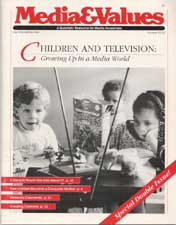Wired Bedrooms: Kids' Media Choices Made Behind Closed Doors
|
This article originally appeared in Issue# 52-53
|
The bedrooms of students in Santa Barbara County, California are wired. Television, telephones, stereos, radios and VCRs abound in striking numbers. Judging from the results and demographics of a study of media use by students in the Santa Barbara County school district in 1989, my guess is that this is the case almost everywhere.
We asked the 50,000 students in our county about their media consumption: How much TV do they actually watch? Outside of school assignments, do they ever read newspapers? Magazines? Books? And we included a question about the electronic items they have in their bedrooms.
We distributed the survey throughout the county's 23 school districts. Because its demographics couldn't be precisely controlled, we can't claim the results are statistically accurate. But the sheer size of the sample – 21,364 useable responses from students in kindergarten through twelfth grade – appears large enough to indicate some very significant trends.
The question on use of bedroom electronic equipment proved to be the most eye-opening of the survey. Up and down our county, a whopping 44 percent of the K- l2 population reported having television sets in their bedrooms, and nearly 13 percent reported VCRs in their bedrooms. Ironically, the percentages were higher in areas with lower socio-economic levels (as much as 60 percent or more), and in districts with more whose families are migrant workers. In solid middle-class areas, the percentages of students with bedroom TVs dropped to an average of 30 to 35 percent.
"Sending a child to his or her room takes on a whole new meaning today if the child's room is linked to the outside world through television, radio, telephone and computer."
– Joshua Meyrowitz, No Sense of Place
There may be some practical reasons for this divergence. For example, in some cases, lower-income families may live in homes or apartments with only one major room. Such families also tend to make more use of television for child care and year-round recreation. But the prevalence of televisions in bedrooms was still widespread throughout our large geographic area.
Perhaps the most telling comparison emerged when we correlated the incidence of wired bedrooms with academic performance. Strikingly, we found that "A" students were significantly less likely to have bedroom entertainment technology. Most especially, they owned fewer televisions, stereos and telephones. This last figure apparently struck a nerve among our community members. In fact, many parents called to report "pulling the plug" in their children's bedrooms after reading the report we issued on the study.
But the reality is that media are omnipresent. Children will continue to be exposed to media messages in alarming quantities, even when parents attempt to restrict the quantity and content viewed at home. There are always friends' houses and other means available. Concerned parents and educators need to remember that the viewing of TV shows and films– even those that we would prefer to have our young people avoid altogether– need not be a negative experience. Young people can be trained to recognize the values messages contained in the media they receive and evaluate them in an appropriate context.
It is clear that it is extremely important both to teach our young people these critical viewing skills and to have parents pay attention to the types and amounts of programs their children watch. It will always be difficult to monitor what children watch, play and listen to on the other side of the bedroom door. In the end, critical viewing skills are the best way to extend parental influence into the wired bedroom.



